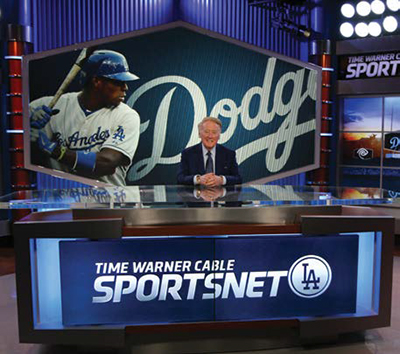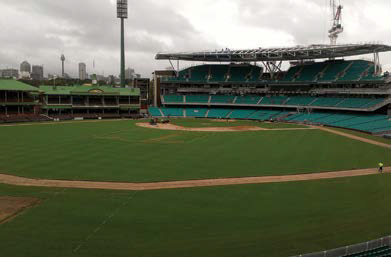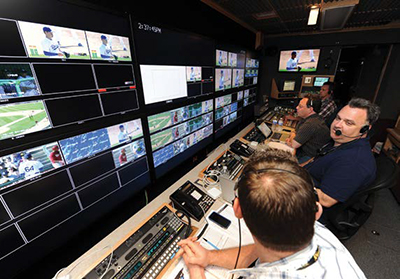Dodgers Debut SportsNet LA

Hall of Fame sportscaster Vin Scully will start his 66th season calling the plays at Dodger Stadium. Scully is the longest-serving broadcaster in history for any major league sports team.
LOS ANGELES—The Los Angeles Dodgers and their ardent fan base can focus on the 2014 season, which will also be memorable for the establishment of SportsNet LA, the team-owned regional sports network that’s dedicated to the boys in blue, present and past, ’round the clock.
The debut of SportsNet LA, which is valued between $8 billion and $9 billion, is just the latest point in the trend of Major League Baseball teams establishing and owning RSNs. With the game broadcasts and the pre- and post-game shows accentuated by a growing number of servers brimming with content, it was only a matter of time before the storied franchise that came ‘to Tinseltown in 1958 (after its earlier days in Brooklyn) got on board.
Establishing the technical setup for SportsNet LA was a relatively easy and workable, proposition, as the infrastructure for the Time Warner Cable-operated entity was virtually piggybacked on to the existing TWC SportsNet (carrier of the Los Angeles Lakers, Los Angeles Sparks and the Los Angeles Galaxy, as well as various local sports), which launched in October 2012, also at TWC’s 40,000-square-foot operations center in El Segundo, Calif.
IT’S ABOUT THE CONTENT

Programming for SportsNet LA emanates from three sources: The first is the actual game production by the Dodgers, which is filtered through TWC.
“Our DMA expands northeast to Las Vegas southwest to the Hawaiian Islands,” said Larry Meyers, vice president of content for TWC and executive producer for the RSN. “And now, all Dodgers exhibition games and more than 140 of the 162 regular season games [with 75 in Spanish] will air on SportsNet LA.”
The professional video industry's #1 source for news, trends and product and tech information. Sign up below.
The second element is the studio shows: “Leadoff Space LA,” and the pre/post-game show, called “Access SportsNet: Dodgers,” which airs an hour before and an hour after each game; plus “Dodgers Squeeze Play,” an hour-long condensed version of the prior day’s game; with the third element consisting of other new programming and archival content, notably “Backstage Dodgers” and “Dodgers Clubhouse.” Both shows will be lensed with less obtrusive small cameras, like Canon 5Ds and Sony F55s.
Dodgers, Diamondbacks Lead Off
’14 Season Down Under
The Sidney Cricket Ground was redesigned to host its first ever professional baseball game.

While a two-game series is more the exception than the rule during the Major League Baseball season, playing a short set on the other side of the International Date Line is another matter.
But that’s what the Los Angeles Dodgers and the Arizona Diamondbacks did on Saturday and Sunday, March 22-23, at the fabled Sydney Cricket Ground. In the process, they became the first two teams to play in Australia since the Chicago White Sox and New York Giants did so during a tour 100 years ago.
While the experiment was certainly novel and [hopefully] raised the sport’s profile on another continent, previous regular season MLB openers were played in baseball-crazy countries like Japan and Mexico, and didn’t necessarily present unusual conditions—like playing in a more circular cricket stadium.
Meyers admitted that he braced for a few surprises. “I didn’t know all of the details,” Meyer said just before press time, “but since the Sydney Cricket Grounds is not a baseball park, there had to be a lot of cable installed.”
SLIGHTLY ALTERED
That figured in to be the case, since the venue had an expanse of foul territory that was reminiscent of the O.co Coliseum, in Oakland, Calif., as well as what seems like an acre or two between the outfield fence and the stands. Viewers also noticed, as reported by NPR’s Tom Goldman and others, the bare spot behind second base; that was the 22-yard cricket pitch, which the groundskeeper refused to alter for the games.
As for the broadcasts, MLB International, the host broadcaster, spent several months in planning with entities like Australia’s Global Television (part of Pittsburgh-based NEP Group), the primary equipment vendor. Its host truck produced a primary feed of the game and was accompanied by two additional large mobile units.
The host feed drew from a large number of cameras (approximately 14, of various types) and was the source for distributors MLBI, which partnered with ESPN to transmit the games in Australia, as well as New Zealand, the Pacific Islands, Latin America and the Caribbean; SportsNet LA and FSN Arizona; and Australia’s Nine Network, which simulcast the games.
SportsNet LA operated a separate unilateral truck in order to take a clean world feed and craft a complete program that was branded to the new RSN’s look, with the commentary of Dodger legend Vin Scully (yes, the 86-year-old took that 14-hour flight). It also provided pre-game and post-game portions of its studio/site hybrid with on-site sideline reporter Alanna Rizzo.
The SportsNet LA truck added three cameras, plus the EVS, Chyron Duet, GVG Kalypso switcher, etc. FSN Arizona, similarly, worked with a separate unilateral truck, also taking the world feed and crafting its broadcast.
It’s also notable, said Meyers, that “the entire production was being natively produced in Sydney in 1080i/59.94, despite Australia being a 1080i/50 country.” MBLI used Pac-TV as the transmission provider back to the U.S. from Australia.
A group of about 10 from SportsNet LA traveled to Sydney for the event, which meant working with local crews and versing them on the finer points about broadcasting baseball. They got a head start by working with MLBI on the two Australian National Team exhibition games, one each against the Dodgers and D-backs, in the days before both squads took the field for real.
True, he may have had some nervous moments leading in, but Meyer felt the broadcasts would come off well, for good reason. “My personal experience at the Australian Open,” he said, “and that’s how I knew that Australia provides excellent crew, gear and effort.”
At the operations center, TWC Sports has used about a quarter of its existing facility to accommodate SportsNet LA, with the full facility including two master control breakout rooms (with one dedicated for the Spanish broadcasts) in the “nerve center.” It also includes five stages, including one insert; four control rooms, including video control and replay; 11 edit rooms that feature Final Cut Pro technology; and an audio post-production room with equipped with Avid ProTools.
A NEW VIEW
Although only five or six cameras per game were employed by SportsNet LA during its Cactus League broadcasts, the regular season home games will feature about a dozen Sony HDC-2500s.
Most of the cameras will be set in the typical positions that are employed during a baseball broadcast. In Dodger Stadium, that means in the Dodgers’ third base dugout, low third, high home, in the booth with legendary Hall of Fame broadcaster Vin Scully, high first and low first, with two in centerfield (high and low) and a rover in right field, plus two or three robocams behind home plate. Two of the robocams behind home will shoot at high frame rates, with one Ultra Mo.
What’s new will be a camera mounted in the upper deck in leftfield, which will provide a fresh angle down the first base line. “One thing we did was go to Dodger Stadium to work with Jared Stacy,” TWC’s coordinating producer for remote production, said Meyers. “We looked around for good story-oriented spots for camera positions. The producers call it ‘showing relativity.’”
Ultimately, the new setup was created to allow SportsNet LA to tell the story of the game to Dodger fans in a way that it hasn’t been told before. “What we really wanted to do is create a story that is not just about the players on the field, but the Dodgers fans and their connection to the team,” said Meyers. “That’s why the Dodgers started the network.”
SENDING SIGNALS
It also came in handy that SportsNet LA was founded shortly after the Dodgers upgraded the in-house video facilities at the stadium for “DodgerVision,” the stadium’s 26 x 46-foot 16:9 SD screen from Daktronix, which, along with the Cincinnati Reds, is the largest SD video screen in the Major League Baseball. DodgerVision includes the video screen, scoreboard in right field, outfield wall boards in the left and right field fences, Loge and Field level fascia boards.

SportsNet LA’s “nerve center” Building SportsNet LA was basically another case of piggybacking that, on this occasion, satisfied TWC’s infrastructural needs.
“The stadium is cabled well and the vast majority of the infrastructure was already in place, even down to the clubhouse. That’s unusual,” said Mark Coleman, vice president of engineering, facilities and operations. “It already had access to routable, patchable cable. It was a benefit to us that DSI, through Sony, did a great job with the upgrade,” before the start of the 2013 season.
The truck provider at Dodger Stadium is Wilsonville, Ore.-based MIRA Mobile, which is dispatching its M-12 unit this season. The 53-foot HD Expando houses 12 Sony HDC-2570 cameras, a GVG Kayenne switcher, five EVS servers, Calrec Artemis audio mixer, Chyron HD Duet, and Evertz router.
Transmission from the stadium to El Segundo is another mark of technical advancement, Coleman said. “We can bundle outbound feeds from the stadium, but it’s a two-way environment. It’s more than point-A-to-point-B. Now, we can send up to five signals from the truck, then also send transmissions back from the nerve center.
“That,” he said, “is a game changer.”
The SportsNet LA news room features Dalet media asset management, with the RSN’s 150 TB of content in a Spectra Logic library, backed up on several Quantum servers.
IN THE GAME
The biggest technical leap for this season will be the integration of VizLibero, a graphics analysis tool, into the broadcasts. “To call it a super telestrator doesn’t give it full credit,” said Coleman, noting its interpolation of multiple camera angles on the same play to “create a 3-D, Matrix-like representation” of exciting plays.
And exciting is just what he and Meyers want this season’s broadcasts of Dodgers baseball to be. Meyers feels that SportsNet LA’s presentation will give Dodger fans access to an experience that they could never have expected.
“We’re really pleased with where we are,” he said. “Dodger fans now have a level of interaction that they’ve never had before.”
Mark R. Smith has covered the media industry for a variety of industry publications, with his articles for TV Technology often focusing on sports. He’s written numerous stories about all of the major U.S. sports leagues.
Based in the Baltimore-Washington area, the byline of Smith, who has also served as the long-time editor-in-chief for The Business Monthly, Columbia, Md., initially appeared in TV Technology and in another Futurenet publication, Mix, in the late ’90s. His work has also appeared in numerous other publications.

